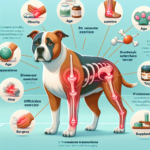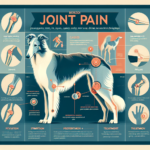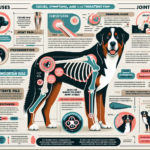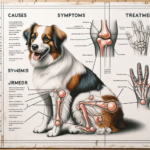Wirehaired Pointing Griffon Joint Pain: Causes, Symptoms, Prevention, and Treatment
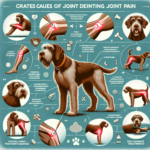
Introduction
The Wirehaired Pointing Griffon, often referred to as the “Griffon,” is a versatile and energetic breed known for its excellent hunting skills and distinctive wiry coat. Originating in the late 19th century, this breed was developed by Eduard Karel Korthals in the Netherlands and Germany. The Griffon is celebrated for its keen sense of smell, intelligence, and friendly disposition, making it a popular choice among hunters and families alike.
While the Wirehaired Pointing Griffon is generally a healthy breed, it is not immune to certain health issues. Common concerns include hip dysplasia, eye conditions, and ear infections. Among these, joint pain is a significant issue that can affect the breed’s quality of life.
Joint health is particularly crucial for the Wirehaired Pointing Griffon due to its active lifestyle and working nature. Maintaining healthy joints ensures that these dogs can continue to perform their duties and enjoy a high quality of life well into their senior years.
Breed-Specific Joint Pain Risks
Genetic Predisposition
The Wirehaired Pointing Griffon is genetically predisposed to several joint-related issues, including hip dysplasia, elbow dysplasia, and arthritis. Hip dysplasia is a condition where the hip joint does not fit into the hip socket properly, leading to pain and mobility issues. Elbow dysplasia involves abnormal development of the elbow joint, causing lameness and discomfort. Arthritis, a degenerative joint disease, can also develop as the dog ages, leading to chronic pain and stiffness.
Age-Related Risks
As the Wirehaired Pointing Griffon ages, the risk of developing joint pain increases. Typically, signs of joint issues may start to appear around middle age, which for this breed is around 5 to 7 years old. Senior Griffons, those over 8 years old, are particularly susceptible to arthritis and other degenerative joint conditions.
Activity Level and Joint Stress
The Wirehaired Pointing Griffon is an active and energetic breed, often used for hunting and other high-intensity activities. While regular exercise is essential for their overall health, excessive or inappropriate exercise can put undue stress on their joints. Activities that involve a lot of jumping, running on hard surfaces, or sudden changes in direction can exacerbate joint issues.
Common Symptoms of Joint Pain in Wirehaired Pointing Griffons
General Symptoms
- Limping or favoring one leg
- Stiffness, especially after rest or sleep
- Reluctance to climb stairs or jump
- Decreased activity or playfulness
- Swelling around the joints
- Whining or showing signs of discomfort when touched
Breed-Specific Symptoms
In Wirehaired Pointing Griffons, joint pain may manifest as a reluctance to engage in hunting or other high-energy activities they once enjoyed. Owners may also notice a change in their gait, such as a “bunny hop” when running, which can indicate hip dysplasia.
When to Consult a Vet
If you observe any of the above symptoms in your Wirehaired Pointing Griffon, it is essential to consult a veterinarian promptly. Early diagnosis and intervention can significantly improve the prognosis and quality of life for your dog.
Preventive Measures for Joint Health
Exercise Recommendations
Regular, moderate exercise is crucial for maintaining joint health in Wirehaired Pointing Griffons. Activities such as swimming, walking on soft surfaces, and controlled play can help keep their joints flexible and muscles strong without causing excessive stress. Avoid high-impact activities like jumping or running on hard surfaces.
Dietary Suggestions
A balanced diet rich in essential nutrients can support joint health. Look for dog foods that contain glucosamine and chondroitin, which help maintain cartilage health. Omega-3 fatty acids, found in fish oil supplements, can also reduce inflammation and support joint function. Always consult your veterinarian before adding supplements to your dog’s diet.
Weight Management
Maintaining a healthy weight is crucial for reducing joint stress. Overweight dogs are more prone to joint issues due to the extra load on their joints. Monitor your Wirehaired Pointing Griffon’s weight and adjust their diet and exercise routine as needed to keep them at an optimal weight.
Early Screening and Monitoring
Regular veterinary check-ups are essential for early detection of joint issues. Screening tests such as X-rays can help identify conditions like hip or elbow dysplasia before they become severe. Early intervention can slow the progression of joint diseases and improve your dog’s quality of life.
Treatment Options for Joint Pain
Non-Surgical Treatments
Non-surgical treatments for joint pain in Wirehaired Pointing Griffons include medications, physical therapy, and lifestyle adjustments. Nonsteroidal anti-inflammatory drugs (NSAIDs) can help manage pain and inflammation. Physical therapy, including exercises and hydrotherapy, can improve joint mobility and strength. Lifestyle adjustments, such as providing a comfortable bed and avoiding high-impact activities, can also alleviate joint pain.
Surgical Options
In severe cases, surgical intervention may be necessary. Common surgical options for joint pain include hip replacement, arthroscopy, and joint fusion. These procedures can significantly improve mobility and reduce pain, but they come with risks and require a lengthy recovery period. Consult with a veterinary orthopedic specialist to determine the best course of action for your dog.
Alternative Therapies
Alternative treatments such as acupuncture, hydrotherapy, and massage can also benefit Wirehaired Pointing Griffons with joint pain. Acupuncture can help reduce pain and inflammation, while hydrotherapy provides low-impact exercise that strengthens muscles without stressing the joints. Massage therapy can improve circulation and reduce muscle tension, providing relief from joint pain.
Lifestyle and Management Tips
Daily Care Routine
A consistent daily care routine can help manage and alleviate joint pain in Wirehaired Pointing Griffons. This routine might include gentle exercise, a balanced diet, and regular administration of any prescribed medications or supplements. Monitoring your dog’s behavior and adjusting their activities as needed can also help manage their condition.
Modifying the Home Environment
Making your home more comfortable for a dog with joint pain can significantly improve their quality of life. Consider adding ramps to help them navigate stairs, providing orthopedic beds for better joint support, and placing non-slip mats on slippery surfaces to prevent falls.
Long-Term Management
Long-term management of joint pain involves regular veterinary check-ups, ongoing weight management, and consistent use of prescribed treatments. Keeping your Wirehaired Pointing Griffon active and engaged with low-impact activities can help maintain their physical and mental well-being despite joint pain.
FAQs About Wirehaired Pointing Griffons and Joint Pain
What are the early signs of joint pain in Wirehaired Pointing Griffons?
Early signs of joint pain include limping, stiffness, reluctance to move, and decreased activity levels. If you notice any of these symptoms, consult your veterinarian for a thorough evaluation.
Can joint pain in Wirehaired Pointing Griffons be prevented?
While it may not be possible to prevent joint pain entirely, you can reduce the risk by maintaining a healthy weight, providing appropriate exercise, and ensuring a balanced diet rich in joint-supporting nutrients.
Are there specific exercises that are better for Wirehaired Pointing Griffons with joint pain?
Low-impact exercises such as swimming and walking on soft surfaces are ideal for Wirehaired Pointing Griffons with joint pain. These activities help maintain joint mobility and muscle strength without causing excessive stress.
What dietary supplements can help with joint health in Wirehaired Pointing Griffons?
Supplements containing glucosamine, chondroitin, and omega-3 fatty acids can support joint health. Always consult your veterinarian before adding any supplements to your dog’s diet.
When should I consider surgery for my Wirehaired Pointing Griffon’s joint pain?
Surgery should be considered when non-surgical treatments are no longer effective, and your dog’s quality of life is significantly impacted. Consult with a veterinary orthopedic specialist to discuss the best surgical options for your dog.
Conclusion
Joint pain is a common issue that can significantly impact the quality of life for Wirehaired Pointing Griffons. By understanding the causes, symptoms, and preventive measures, owners can take proactive steps to ensure their dog’s joint health. Regular veterinary check-ups, appropriate exercise, a balanced diet, and weight management are crucial for preventing and managing joint pain. If joint issues do arise, a combination of non-surgical treatments, surgical options, and alternative therapies can provide relief and improve mobility. By taking these steps, you can help your Wirehaired Pointing Griffon live a happy, active, and pain-free life.

